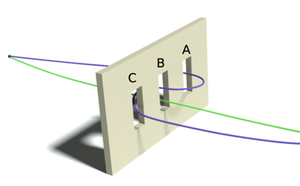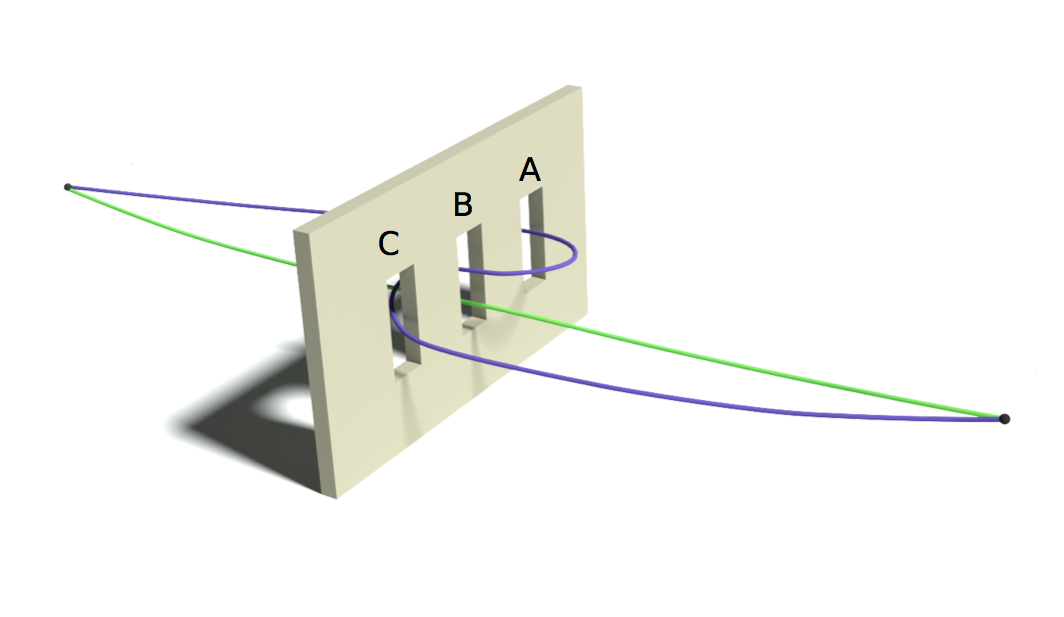Curvy Photon Trajectories Could Be Detectable
Standard quantum mechanics problems such as the classic double-slit experiment usually assume that particles can only follow straight-line trajectories and ignore more exotic, looping paths that are much less likely. Now researchers have calculated the exotic path contribution for particles in multi-slit experiments, effects that were previously known but not precisely calculated. The team shows that the effects of these “nonclassical” paths could be observable in high-precision experiments.
In the quantum double-slit experiment, a beam of particles (usually photons or electrons) is shot through a mask with two closely spaced slits, and a device on the far side detects particles and records their positions. The measurements reveal a so-called interference pattern with alternating stripes of high and low incidence, exactly what would be expected if classical waves were emitted from the slits, rather than particles. The particle beam’s wavelike behavior can be characterized with a wave function that gives the probability (once you square it) of detecting a particle at any location. It is often assumed that the wave function for both slits open is the sum (or superposition) of two single-slit wave functions—one with just slit A open and one with just slit B open. “This misconception has been around for a long time,” says Urbasi Sinha of the Raman Research Institute in Bangalore, India. In fact, the exact solution is more complicated, because what happens at slit A is influenced by the state of slit B (open or closed).
Sinha and her colleagues have explored the implications of this misconception and how it may affect actual experiments. Previous studies have roughly estimated the size of the effect [1] or performed analogous simulations in classical electromagnetism [2]. But Sinha and her collaborators have now analytically calculated the most important parts of the correction to the simplistic theory, showing how they depend on experimental parameters. She says that previously no one had formulated the problem precisely enough to perform such calculations.
The team chose to work with a three-slit problem, in which the predicted effect is more noticeable. Their calculations are based on the Feynman path integral formalism, in which the probability of the particle reaching the detector is the sum over all possible paths that connect the initial and final points. Each path is given a “weight,” or probability of being followed, based on the potential energy barriers within the experiment. Certain paths are strange looking, with spirals, kinks, or loops, but most of these paths have negligible weight compared with straight paths. However, some of these nonclassical paths do contribute noticeably to the overall probability.
To quantify the contribution from nonclassical paths, the team considered a parameter defined as the difference in particle detection probability between the case with three slits open and other cases with two slits or one slit open. This difference parameter is exactly zero if one assumes that the triple-slit wave function is just a simple superposition of three single-slit wave functions. But if one is more careful and considers nonclassical paths, then one finds a nonzero contribution from paths that cross through the slits more than once.
The team looked at a specific case—a triple slit experiment with single infrared photons that Sinha and other colleagues performed in 2010 [3]—and they found that the difference parameter could be one millionth of the central maximum detection probability in the interference pattern. This value is too small to have been observed in the 2010 experiment, but the difference parameter becomes larger with wavelength. It can reach as high as one thousandth of the central maximum for microwaves, the team predicts. Sinha says she and her colleagues are now investigating a microwave experiment that could test this effect.
“Quantum mechanics is sometimes counterintuitive, so maybe it is not surprising that … there is some effect of very unusual paths,” says Ray Laflamme of the University of Waterloo in Canada. The nonclassical contributions may be relevant to future high-precision experiments, says Barry Sanders from the University of Calgary in Canada. Researchers are planning to use multi-slit interference experiments to look for deviations that might match predictions from quantum theories of gravity or other “new physics” theories. In addition, certain quantum computer designs that use interferometry will need to take into account nonclassical path effects. The authors “introduce a formalism that makes it easy to estimate the correction terms,” Sanders says.
This research is published in Physical Review Letters.
–Michael Schirber
Michael Schirber is a Corresponding Editor for Physics Magazine based in Lyon, France.
References
- H. Yabuki, “Feynman Path Integrals in the Young Double-Slit Experiment,” Int. J. Theor. Phys. 25, 159 (1986)
- H. De Raedt, K. Michielsen, and K. Hess, “Analysis of Multipath Interference in Three-Slit Experiments,” Phys. Rev. A 85, 012101 (2012)
- U. Sinha, C. Couteau, T. Jennewein, R. Laflamme, and G. Weihs, “Ruling Out Multi-Order Interference in Quantum Mechanics,” Science 329, 418 (2010)





